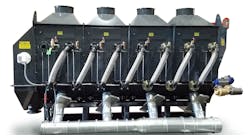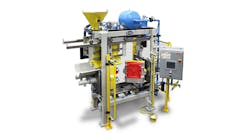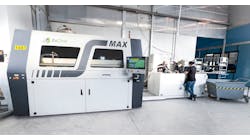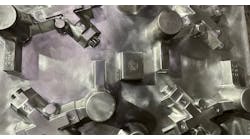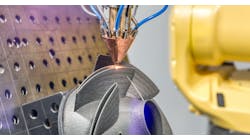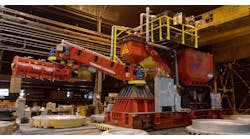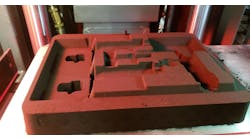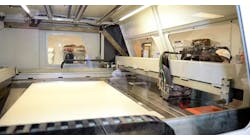Metalcasting researchers say hot sand is the leading sand-related problem for today’s foundries. Most metalcasters recognize a relationship between reduced casting quality, increased process variation, and other molding inefficiencies that result from using hot molding sands. Studies show that hot sand affects virtually every operation in the production line.
System sand returned to the muller for reconditioning with a temperature of 160°F (approximately 70°C) or greater is considered to be excessively hot. Return sand ranging from 120° to 160°F (approx. 49°-70°C) is hot enough to demonstrate inconsistent properties during mixing and to be very difficult to control.
Where does it come from?
In a regenerative green-sand system the composition of the sand mixture is formulated to meet the requirements of the molding method being used and the type of casting being produced. The typical system sand consists of varying percentages of sand, clay, organic additives, and water. The system muller and molding machine process this mixture into a finished mold. To form a casting, molten metal is introduced to the mold, and in the process extensive damage occurs to the mold material (the green sand mixture). The damage (heat is the primary concern here) will vary according to the location of the material in the mold.
As molten metal is poured into the mold the sand grains expand - some by more than 10%. During this expansion some sand grains will experience thermal shock and crack apart. The effect of this shock is the most severe at the mold/metal interface anddiminishes further from the mold face. As the sand grains at the mold/metal interface are maintained at a high temperature for a period of time, they may go through a physical modification. The clay additives in the green-sand mold lose their combined water and structure. At this point the clay has lost its plasticity and it cannot be regained by subsequent new water addition.
Calcium bentonite is destroyed at 850°F (455°C) and sodium bentonite at 1,150°F (620°C). The water in the mold evaporates as the temperature in the sand mixture exceeds 212°F (100°C), until all the free water has evaporated.
Some of the water that has evaporated is carried through the mold with hot air and condenses in a layer behind the mold face. As a result of this overall process, the green-sand mold now consists of many layers of sand with properties ranging from the very hot, hard, and brittle layer at the mold face, to the relatively cool, wet, and plastic layer at the mold back.
Once the casting cools the sand is separated from the casting at shakeout and re-enters the sand system. Typically, the hot dry sand is the first part of the mold to re-enter the system followed by the colder, wetter backing sand. The return sand is segregated in surges of sand with vastly different properties, in terms of temperature, moisture content, and clay level.
A sand system may also gain heat from rapid sand system turnover, low sand-to-metal ratios, or high ambient temperatures. Combinations of all of these factors can be found in many metal casting plants.
Cooling equipment
There are several types of equipment to cool shakeout sand:
Rotating Cooling Drums. The cooling drum is popular because it’s simple, but its inefficiencies outweigh its apparent benefits. In the cooling drum, sand is fed into one end of a large, inclined rotating drum. Often the downhill side of this drum incorporates a rotary screen. Air is pulled through the drum by an exhaust fan. Because sand moves slowly through the drum, a major requirement for effective sand cooling is ignored: the constant exposure of fresh surface area to the air stream in order to achieve the highest degree of cooling. Plus, due to the slow movement, the sand actually moves through the drum as a ‘slug’ and variations of sand are not mixed.
Mixing sand from various zones of the mold, or from unpoured molds, into hot sand originating from the sand/metal interface is considerably less than satisfactory. Sand leaving the cooling drum exhibits inconsistent properties (temperature, moisture content, etc.)
Stationary Cooling Drums with Rotating Paddles. — Like the rotary drum, sand enters at one end of an inclined stationary drum and advances through it by lifting paddles or shelves rotating around a central shaft. Air is pulled through side openings and exhausted out the top. The performance is similar to the rotating drums.
Sand Cascades. —Hot sand is dropped from cascade towers through a series of baffles; or it is plowed off stacked shelves, dropping from one shelf to the next lower one. Air is pulled up through both types of units, counterflow to the direction of sand travel. Sand cascades are not effective for modern foundries’ cooling problems.
Vibrating Fluid-Bed Coolers. — Fluid-bed coolers are popular with foundries, but a number of factors limit their effectiveness. Sand is fed to the inlet end of a double-deck vibrating conveyor. The upper deck consists of a plate perforated with many small holes or a small opening screen mesh. The sides and lower deck of the conveyor form an air plenum under the upper deck. Pressurized air is blown into the air plenum and passes through the upper deck as many small, high-velocity jets. These air jets keep the sand from falling through to the lower deck and act as cooling and fluidizing air in the sand.
In practice, a number of technical and practical problems occur. A fluid bed, by definition, processes particulate matter where the particles have identical (or near identical) diameters. Basic physics explains a critical weakness; if not suspended, each particle in the bed would fall down under its own weight. The weight of a particle is proportional to its diameter cubed. In order to have a fluid bed, air is forced from below through the sand mass and the pressure of the air on the sand grains keeps them suspended. This forced air is acting on differing areas, however.
Molding sand does not consist of identically sized particles but rather of particles in a wide range of sizes. Generally, foundry sand has a grain-size range of 1:10. An 80-mesh silica particle will be in suspension at an air velocity of approx. 10.5 ft/sec. (3.2 m/sec.) However, the speed of the air will have to be higher because material in the 70 and 50 mesh range also must be in suspension in order that it does not settle out at the bottom.
On the other hand, bentonite (clay less than 20 micron diameter) is already in suspension at air speeds of approx. 1 ft/sec. (0.3 m/sec.) The result is that the fluid-bed systems tend to segregate and remove a lot of fines and clay that, in view of foundry economics and process needs, must be retrieved and reintroduced into the system. As a compromise engineers typically select a lower air velocity, which then results in the small air inlet holes becoming clogged with sand, with an associated loss of capacity and cooling effect.
Buderus AG researchers found that in fluid-bed systems the discharged air “contains considerable quantities of dust (approximately 15% of the dust from the foundry sand) ... the high discharge of dust is due to the requirement that the floor sand moisture must be lower than 1.5%, which does not have to be the case with coolers with mixing arms,” (i.e., the Simpson Multi-Cooler®. The same study documents a 15% greater cooling effect by the Multi-Cooler.) Fluid-bed coolers’ segregating tendencies are aggravated by an inability to blend the variations of return sand.
Cooling in the muller. Although it provides a degree of relief in some systems, most modern foundry engineers view cooling in the muller as an undesirable technical compromise. The process of adding cooling air and fluidizing the sand mass for effective cooling is a direct contradiction to the activities necessary for effective final mixing. At best, mulling cycles will be lengthened and the system mixing capacity reduced.
Some of this equipment can cool effectively when carefully applied to systems where the sand properties are well in control and unusually consistent. However, none of them can “blend out” minute-to-minute fluctuations in sand temperature, moisture, or degree of additive burnout. None of them can effectively back-blend the sand leaving the discharge end with incoming sand. Therefore, none can guarantee the control of the moisture, temperature, and the physical characteristics of the sand being discharged, to provide a uniform product entering the storage bin ahead of the mullers.
An ideal system
Simpson Technologies Corp.’s Multi-Cooler® was introduced commercially in 1966. It was conceived as continuous cooler using many of the same principles as the successful Simpson Multi-Mull continuous muller.
The Multi-Cooler’s controls add a measured amount of cooling and tempering water to ensure it continuously discharges cool sand within a controlled moisture range. Recent advancements include a method for making the bond (bentonite) addition in the Multi-Cooler, to increase the benefits of premixing. In this system, the muller group accepts the sand from the Multi-Cooler and makes the final moisture and bentonite additions for the optimal sand mixture.
Since the Multi-Cooler averages out variations in temperature, moisture, and degree of additive burnout, the mixer group following it is fed uniformly cool sand with closely controlled moisture content and physical properties. The mixer group, also equipped with sophisticated automatic controls, can develop the maximum potential of the green sand-mixture without the inefficiency of adjusting to inconsistent charge materials. The sands’ physical properties can be continuously and automatically controlled to new levels of quality - with minimum power, time, labor, and capital investment.
In recent years, the Multi-Cooler’s control capabilities have made it especially popular with technically advanced, and highly competitive, automotive foundries.
High-speed, automatic, high-pressure molding systems underscore the need for extreme uniformity in prepared molding sand, but without process control such operations also generate more scrap. Foundry economics, and competition, demand continuous reduction in sand-related scrap.
Sand mixtures have to be controlled within very narrow limits. But, that control is difficult to attain because automatic moisture- and bond-control equipment cannot compensate for wide fluctuations in sand temperature, moisture, and degree of additive burnout in returned sand.
Sophisticated, on-line mixer group controls are available, and they are more effective than conventional mixing systems. Using sensors and control logic, modern on-line controls (e.g., the Hartley® Compactability controller) quickly and automatically adjust to many return-sand variations and sand-related casting scrap is reduced. But, even the best controllers cannot adjust to all the varying return-sand conditions found in most foundries.
To minimize sand-related casting scrap further and optimize the green-sand molding process it’s necessary to add cooling and pre-mixing technology to the sand plant. Adding a Multi-Cooler into the system allows the sand-preparation plant to develop sand qualities to optimum levels.
The Multi-Cooler makes it possible to place sand of a uniform moisture and temperature level into the sand system ahead of the critical mixing stage. Sand cooled to approx. 10-15°C above ambient can discharge from the cooler at 1.5% to 2.0% moisture - and it can be maintained at this level. Minute-to-minute variations in additive burnout average out and variations in the sand properties are addressed by pre-mixing. Now, sand delivered to the mixer group is so uniform that on-line controls in the mixer group can attain a degree of prepared sand uniformity and strength not possible with conventional sand systems.
A complete sand preparation plant integrated with the Simpson Multi-Cooler and a modern muller (such as the Simpson Mix-Muller®, Simpson Multi-Mull® or Beardsley & Piper Speedmuller®) equipped with automated controls (such as the Hartley® 18Mk2/2502 Compactability controller or 18Mk2/2552 compactability controller with bond determination feature) as the heart of the system can operate automatically and continuously, with a minimum of labor, power, downtime, and initial capital investment.
This article is based on a report by the technical staff at Simpson Technologies Corp. The complete report is available at www.simpsongroup.com
The Effects of Hot Sand
Hot sand will effect every aspect of a green-sand molding operation. Depending on the foundry’s ability to control the sand temperature, the effects may range from higher scrap rates and casting costs to a complete loss of system control. Most important, though, are casting defects, such as:
Pin Holes — Cavities in the casting surface, either spherical, flattened, or elongated.
Dirt Inclusions — Surface or sub-surface particles of sand, slag, dross, or oxides which are embedded in the metal.
Washes — Rough spots and areas of excess metal caused by erosion of the mold.
Rough surface — A casting surface that lacks the required degree of smoothness.
Sand stickiness — Excess metal on the surface of the casting caused by a portion of the mold face remaining on the pattern.
Broken molds — Molds that are not strong enough to withstand pouring stresses.
Crushes — Indentations in the castings.

